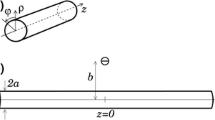Abstract
This paper studies the relative strength of sources associated with the cell and the junction between cells of an equivalent single cardiac fiber. It is shown that the junctional source is negligible compared to the cellular source. On the other hand, the junctional resistance affects the magnitude of the cellular source reducing it by possibly an order of magnitude. The significance of these results to cardiac electrophysiology is that the effect of the junctional resistance may have to be considered separate from that of the cellular resistance.
Similar content being viewed by others
References
Barr, R.C. and R. Plonsey. Propagation of excitation in idealized anisotropic two-dimensional tissue.Biophys. J. 45:1191–1202, 1984.
Bennett, M.V.L. and D.A. Goodenough. Gap junctions, electrotonic coupling and intercellular communication.Neurosc. Res. Prog. Bull. 16:373–486, 1978.
Clerc, L. Directional differences of impulse spread in trabecular muscle from mammalian heart.J. Physiol. 255:335–346, 1976.
Colli-Franzone, P., L. Guerri, C. Viganotti, E. Macchi, S. Baroffi, S. Spaggiari, and B. Taccardi. Potential fields generated by oblique dipole layers modeling excitation wavefronts in the anisotropic myocardium.Circ. Res. 51:330–346, 1982.
Diaz, P.J., Y. Rudy, and R. Plonsey. The intercalated discs as a cause for discontinuous propagation in cardiac muscle: A theoretical simulation.Ann. Biomed. Eng. 11:177–190, 1983.
Plonsey, R. The active fiber in a volume conductor.IEEE Trans. Biomed. Eng. 21:371–381, 1974.
Plonsey, R. and R.C. Barr. Current flow patterns in two-dimensional anisotropic bisyncytia with normal and extreme conductivities.Biophys. J. 45:557–571, 1984.
Roberts, D.E. and A.M. Scher. Effect of tissue anisotropy on extracellular potential fields in canine myocardiumin situ.Circ. Res. 50:342–351, 1982.
Spach, M.S., W.T. Miller III, E. Miller-Jones, R.B. Warren, and R.C. Barr. Extracellular potentials related in intracellular action potentials during impulse conduction in anisotropic canine cardiac muscle.Circ. Res. 45:188–204, 1979.
Spach, M.S. The discontinuous nature of electrical propagation in cardiac muscle.Ann. Biomed. Eng. 11:209–261, 1983.
Author information
Authors and Affiliations
Rights and permissions
About this article
Cite this article
Plonsey, R., Barr, R.C. Effect of junctional resistance on source-strength in a linear cable. Ann Biomed Eng 13, 95–100 (1985). https://doi.org/10.1007/BF02371252
Issue Date:
DOI: https://doi.org/10.1007/BF02371252




